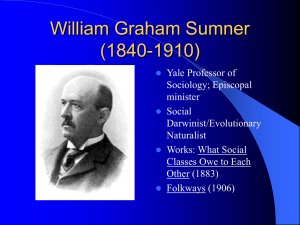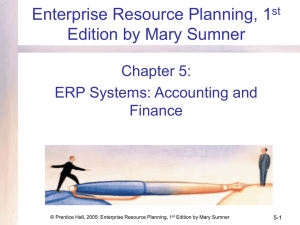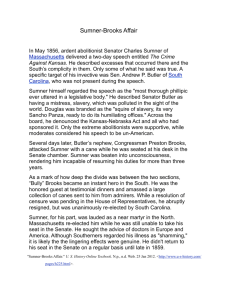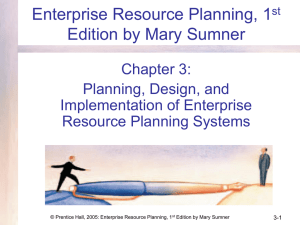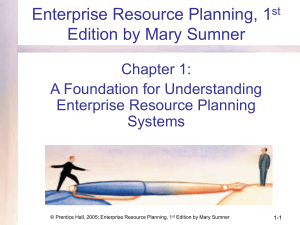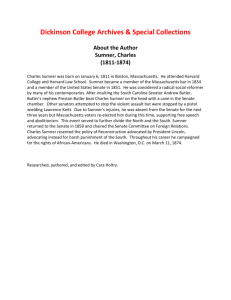ERP Systems: Human Resources
advertisement
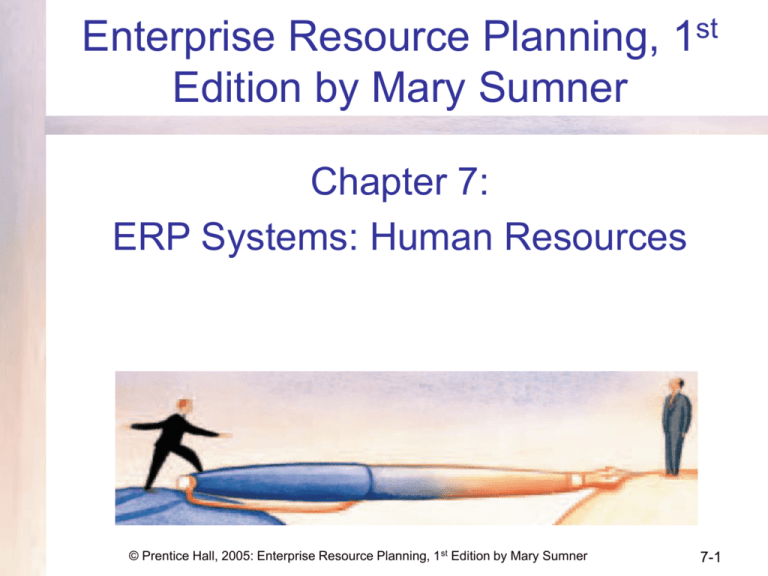
Enterprise Resource Planning, 1st Edition by Mary Sumner Chapter 7: ERP Systems: Human Resources © Prentice Hall, 2005: Enterprise Resource Planning, 1st Edition by Mary Sumner 7-1 Objectives • • Examine the HR processes supported by ERP Understand the interrelationships among business processes supporting human resource management © Prentice Hall, 2005: Enterprise Resource Planning, 1st Edition by Mary Sumner 7-2 Case: Atlantic Manufacturing • • • • • Recruitment, training, and retention of sales force is difficult HR records inadequate HR paperwork and compliance requirements increase steadily Management of compensation packages difficult Needs to create a strategy for controlling the cost of various employee benefits © Prentice Hall, 2005: Enterprise Resource Planning, 1st Edition by Mary Sumner 7-3 Human Resources Problems • • • • • • • Maintaining accurate employee information Job analysis and design Applicant selection Compensation Benefit administration Training Governmental reporting © Prentice Hall, 2005: Enterprise Resource Planning, 1st Edition by Mary Sumner 7-4 Evolution of HR Systems • Traditionally relied upon stand-alone systems – Specialized applications for applicant tracking, compensation, benefits, attendance • Redundant data – No link to financial systems • ERP – Linked to financial systems – “Best practices” © Prentice Hall, 2005: Enterprise Resource Planning, 1st Edition by Mary Sumner 7-5 ERP HR Modules • Components – HR Management • • – Benefits administration • • – Links employee data to actual benefits Allows selection from group of benefits Payroll • – – Personnel records Resumes Paychecks, tax reports, accounting data Time and labor management Employee/Manager self service • • • Travel reimbursement Personnel data and benefits changes Training class © Prentice Hall, 2005: Enterprise Resource Planning, 1st Edition by Mary Sumner 7-6 HR Modules • Attributes – – Integration Common database • – – – – – – Provide audit trails Scalable and flexible Drill-down capability Workflow management for electronic routing of documents and other document management Process standardization Security User friendly and web-accessible © Prentice Hall, 2005: Enterprise Resource Planning, 1st Edition by Mary Sumner 7-7 © Prentice Hall, 2005: Enterprise Resource Planning, 1st Edition by Mary Sumner 7-8 Management Control Modules • • HR information enables management of diverse workforce Supports managerial decision making through query and reporting tools Operational level controls • – – – – – • Strategic level controls – – – – • Maintain and update employee files Job analysis files Design files Regulatory files Skills inventory files Human capital inventory for tracking employees Position control linked to budgeting Labor/management relationships Business intelligence tools for predicting trends Module integration is significant benefit © Prentice Hall, 2005: Enterprise Resource Planning, 1st Edition by Mary Sumner 7-9 Featured Article: Keep Track of Your Employees • • What are the benefits of automated time and attendance records? What advantages might accrue to employees using these systems? © Prentice Hall, 2005: Enterprise Resource Planning, 1st Edition by Mary Sumner 7-10 Featured Article: Keep Track of Your Employees, continued • Employees’ attendance, time at work, and skill levels – – – – • Most companies uncertain If tracked, usually manual Records usually neglected Often piece-meal, no end-to-end solution Benefits of automating – Eliminates manual process • • • • Time-consuming Error-prone Better analysis More control © Prentice Hall, 2005: Enterprise Resource Planning, 1st Edition by Mary Sumner 7-11 Featured Article: Keep Track of Your Employees, continued • Banner Health – Selected Kronos Inc. software • • • Time- and labor-management Accessible from web, phone, badge terminals Information available in real-time – • • Allows for quick staffing adjustments Financial benefits to employees, company Smurfit-Stone Container Corp – Uses Workbrain Inc.’s ERM3, SAP financial applications, and PeopleSoft payroll processing • Web-based employee-relationship management software – – Optimized scheduling and tracking of employees Interfaces with PeopleSoft applications © Prentice Hall, 2005: Enterprise Resource Planning, 1st Edition by Mary Sumner 7-12 Summary • ERP systems include HR modules that offer records management, benefits administration, and payroll – Offer integrated operational and strategic level controls – Scalable and very flexible © Prentice Hall, 2005: Enterprise Resource Planning, 1st Edition by Mary Sumner 7-13
